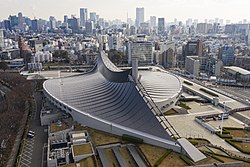
Back صالة يويوجي الوطنية Arabic Kokuricu Jojogi kjógidžó Czech Yoyogi National Gymnasium Danish Kokuritsu Yoyogi Kyōgijō German Gimnasio Nacional Yoyogi Spanish Yoyogi Estadio Nazionala Basque ورزشگاه ملی یویوگی Persian Gymnase olympique de Yoyogi French אולם הספורט הלאומי יויוגי HE Stadion Nasional Yoyogi ID
You can help expand this article with text translated from the corresponding article in Japanese. (February 2022) Click [show] for important translation instructions.
|
Yoyogi | |
 | |
 | |
| Location | 2-1, Jinnan, Shibuya, Tokyo, Japan |
|---|---|
| Coordinates | 35°40′3.0″N 139°42′1.1″E / 35.667500°N 139.700306°E |
| Public transit | Tokyo Metro (at Meiji-jingumae): C Chiyoda Line F Fukutoshin Line JR East: JY Yamanote Line at Harajuku |
| Owner | Japan Sport Council |
| Capacity | 1st Gymnasium:[1]
|
| Construction | |
| Broke ground | February 1963 |
| Opened | October 1964 |
| Architect | Kenzo Tange |
Yoyogi National Gymnasium, officially Yoyogi National Stadium (Japanese: 国立代々木競技場, Hepburn: Kokuritsu Yoyogi Kyōgi-jō) is an indoor arena located at Yoyogi Park in Shibuya, Tokyo, Japan, which is famous for its suspension roof design.



It was designed by Kenzo Tange and built between 1961 and 1964 to be the aquatics center during the 1964 Summer Olympics, with the annex used for basketball events. It was also the venue for the handball competition at the 2020 Summer Olympics.[3] The design inspired Frei Otto's arena designs for the Olympic Stadium in Munich.
The arena holds 13,291 people (9,079 stand seats, 4,124 arena seats and 88 "royal box" seats) and is now primarily used for ice hockey, futsal, basketball and volleyball.[citation needed]
The NHK studios are adjacent to the arena along the edge of Yoyogi Park. Therefore, images of the arena are regularly featured at the end of NHK Newsline broadcasts.[citation needed]
- ^ "第一体育館". www.jpnsport.go.jp (in Japanese). Retrieved 2024-05-17.
- ^ "第二体育館". www.jpnsport.go.jp (in Japanese). Retrieved 2024-05-17.
- ^ "Venue Plan". Tokyo 2020 Bid Committee. Archived from the original on July 27, 2013. Retrieved 11 September 2013.